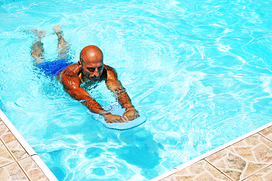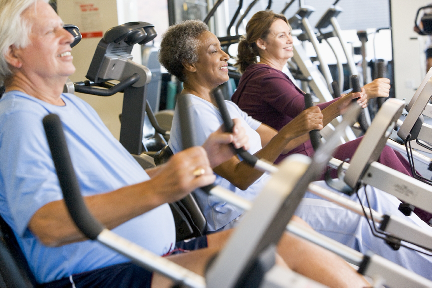 We have all heard the phrase “quality over quantity,” and most of us have even directed this adage at someone else. But do we really believe it? And if we do, why is every gym and fitness center in the country filled with people sacrificing form for a few additional reps and pounds?
We have all heard the phrase “quality over quantity,” and most of us have even directed this adage at someone else. But do we really believe it? And if we do, why is every gym and fitness center in the country filled with people sacrificing form for a few additional reps and pounds?
Before you pick up a weight, start a treadmill, or begin whatever mode of training you have planned for the day, think about your technique. “Where should my feet be?” “Should my hips be under my torso or behind it?” and “How am I going to breathe?” should be some of the questions you ask yourself before getting started.
Common problems associated with poor exercise technique include injuries such as sprains, strains, and fractures. Decreased activation of the desired muscle is also common when performing an exercise incorrectly. I see this most often when people are doing exercises too fast and momentum begins to reduce the work the targeted muscle has to do. All of these technique-associated problems have one thing in common: time.
“Time is more valuable than money. You can get more money, but you cannot get more time,” said Jim Rohn. So stop wasting your time recovering from injuries you got only because you were doing exercises incorrectly or because you had to do extra repetitions since poor form caused the targeted muscle not to fatigue as quickly as it should have.
Here are some workout technique tips for making sure you take the time needed to do the exercises properly and safely.
Use Your Resources
There are countless fitness resources around us, some clearly better than others, that you can consult with to ensure that you are doing exercises properly. The first thing I would recommend you do is research the exercise technique on your own so that you have a general idea of what to expect. Then you should consult with the fitness professional in your active aging community, who can then provide you with cues and possibly hands-on instruction.
Proper Breathing During Exercise
Proper breathing can make the most difficult exercise seem easy. Or it can have the exact opposite effect, making a routine move seem like the end of the world. The most common method of breathing while performing resistance training is to inhale during the eccentric contraction (lowering weight) and to exhale during the concentric contractions (lifting weight). This method of breathing is not the only option an exerciser has, so do your research and find out what is the best method for you, but keep in mind that some variations carry risks. The Valsalva maneuver, for example, can be used when resistance training, but this method of breathing, exhaling against a closed airway, can cause dizziness as the blood levels returning to the heart drop.
Correct Body Position
Once you learn the appropriate body position for your desired exercise, pay attention to it as you execute the reps. The best way to do this is by watching yourself in a mirror. If you notice that your form is beginning to deteriorate and you are not able to correct it, stop the exercise and rest or reduce the weight you are working with. As I mentioned earlier, a few extra reps now are not worth the time you could miss as you recover from an injury.
This year’s tragic bombing of the Boston Marathon has sparked a new saying: “If you see something, say something,” reminding us all that we are the first line of defense when it comes to our own as well as our neighbors’ safety. This motto could also be used in the gym when you see someone demonstrating poor form; say something, but you better make sure you know what you are talking about first.
 What is a tabata workout and why should you try it?
What is a tabata workout and why should you try it?
 We have all heard the phrase “quality over quantity,” and most of us have even directed this adage at someone else. But do we really believe it? And if we do, why is every gym and fitness center in the country filled with people sacrificing form for a few additional reps and pounds?
We have all heard the phrase “quality over quantity,” and most of us have even directed this adage at someone else. But do we really believe it? And if we do, why is every gym and fitness center in the country filled with people sacrificing form for a few additional reps and pounds? It only comes around once per year, so why not indulge with dinner at the fair? Well some of your favorite fair foods might only be consumed once per year, but if you aren’t increasing the amount of exercise to go along with them, the extra weight gained can stick around for longer! Here are some of the more popular fair food items and how far the average person would need to walk around to burn it off!
It only comes around once per year, so why not indulge with dinner at the fair? Well some of your favorite fair foods might only be consumed once per year, but if you aren’t increasing the amount of exercise to go along with them, the extra weight gained can stick around for longer! Here are some of the more popular fair food items and how far the average person would need to walk around to burn it off!
 When you are exercising on an elliptical or stationary bike, it’s easy to go on auto-pilot and stay at the same easy to intermediate level that your body is used to. Next time you find yourself of one of these machines, try adding in some interval training! Intervals will make the heart rate jump, then allow for periods of recovery where the heart rate will fall, thus providing better conditioning for the cardiovascular system and burning more calories than the slower, steady-state cardio.
When you are exercising on an elliptical or stationary bike, it’s easy to go on auto-pilot and stay at the same easy to intermediate level that your body is used to. Next time you find yourself of one of these machines, try adding in some interval training! Intervals will make the heart rate jump, then allow for periods of recovery where the heart rate will fall, thus providing better conditioning for the cardiovascular system and burning more calories than the slower, steady-state cardio. It's the Fourth of July and many of you are probably gearing up to enjoy the outdoors at family gatherings and pool parties. Start your day off right with a workout. During the summer months, exercise is seen as a daunting task by many, however it can be enjoyable if you follow these suggestions for exercising in warm weather.
It's the Fourth of July and many of you are probably gearing up to enjoy the outdoors at family gatherings and pool parties. Start your day off right with a workout. During the summer months, exercise is seen as a daunting task by many, however it can be enjoyable if you follow these suggestions for exercising in warm weather.  Are you one of those people that only use the elliptical machine when told to lie off of exercise due to a lower body injury? Even though most studies have found that the treadmill may burn a few more calories, it’s still important to mix up your workouts. If you are a runner I’m sure you have heard about the importance of cross training your muscles to prevent injuries. The elliptical is a good way to cross train and can be just as challenging!
Are you one of those people that only use the elliptical machine when told to lie off of exercise due to a lower body injury? Even though most studies have found that the treadmill may burn a few more calories, it’s still important to mix up your workouts. If you are a runner I’m sure you have heard about the importance of cross training your muscles to prevent injuries. The elliptical is a good way to cross train and can be just as challenging! Cardiovascular exercise…..people either love it or hate it! I’m sure by now you’ve heard that cardio alone is not the answer to reaching your fitness goals. It is important to add a strength and flexibility component too. Although, cardio and physical activity in general have many health benefits, but they have even more when you “mix it up”!
Cardiovascular exercise…..people either love it or hate it! I’m sure by now you’ve heard that cardio alone is not the answer to reaching your fitness goals. It is important to add a strength and flexibility component too. Although, cardio and physical activity in general have many health benefits, but they have even more when you “mix it up”! I woke up one morning and my obliques were really sore and tender to the touch. I couldn’t figure it out because I hadn’t taught or taken a core class the day before at my corporate wellness site. Then it hit me that the only thing different I had done was sprints. I hadn’t done sprints since track practice, which was a long time ago, but I had no idea how much I use my core! I loved the feeling of my obliques being that sore, so I decided to start incorporating more sprints into my workouts.
I woke up one morning and my obliques were really sore and tender to the touch. I couldn’t figure it out because I hadn’t taught or taken a core class the day before at my corporate wellness site. Then it hit me that the only thing different I had done was sprints. I hadn’t done sprints since track practice, which was a long time ago, but I had no idea how much I use my core! I loved the feeling of my obliques being that sore, so I decided to start incorporating more sprints into my workouts. Physical activity and exercise are two different terms that have similar concepts. Physical activity such as gardening, walking the dog, mowing the lawn, shopping, and taking the stairs gets your body moving. Exercise is a form of physical activity that is specifically planned, structured, and repetitive, such as strength training, yoga, or aerobics class. Both physical activity and exercise are great for seniors to keep up the daily activities they enjoy.
Physical activity and exercise are two different terms that have similar concepts. Physical activity such as gardening, walking the dog, mowing the lawn, shopping, and taking the stairs gets your body moving. Exercise is a form of physical activity that is specifically planned, structured, and repetitive, such as strength training, yoga, or aerobics class. Both physical activity and exercise are great for seniors to keep up the daily activities they enjoy. Ladies and Gentlemen: Start your engines! As the whole town of Indianapolis gears up for the Indy 500, you can test out your endurance abilities with this 500 workout!
Ladies and Gentlemen: Start your engines! As the whole town of Indianapolis gears up for the Indy 500, you can test out your endurance abilities with this 500 workout!